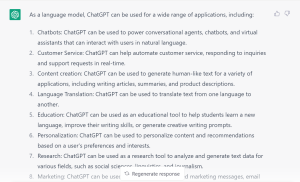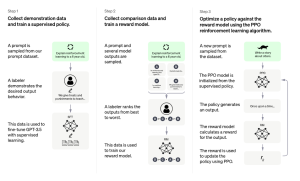Politics
Why the Rise of AI-Generated Content Will Make Link Building Even More Important
Published
1 year agoon
By
Drew Simpson
Artificial intelligence (AI) has been around for decades, but the release of sophisticated tools like ChatGPT is pushing AI-generated content into the mainstream. Marketers are both curious and nervous — understandably — about what this means for the future of marketing and SEO.
With SEO, the biggest question is how AI-generated content will be ranked in Google, whether it will be penalized, and what this low barrier to entry means for the wealth of content that already exists on the internet.
Some of this remains to be seen, but one thing is certain – high-quality content matters more than ever. And that includes link-building for authority.
The Rise of AI Content
AI isn’t a single technology but a collection of technologies that mimic human decision-making and capabilities. It includes machine learning (ML), natural language processing (NLP), rules-based systems, and other similar technologies.
These technologies can understand data and continually learn and improve their processes without specific programming, which is what makes them so valuable and adaptable to many different industries.
AI-generated content is a new development that can streamline content creation with automation. The key is that it can enhance the process, however, not replace it.
What Is AI Content Writing?
AI writing tools, such as the popular ChatGPT, use artificial intelligence to generate content. These tools draw on database resources to respond to queries. There are many possible applications for these tools, as highlighted by ChatGPT itself:
Source: ChatGPT
According to OpenAI, the AI company that launched ChatGPT, the tool “sometimes writes plausible-sounding but incorrect or nonsensical answers.” There are several reasons for this, but it’s mainly because the model can be misled by what it knows, not what the trainer knows.

Source: OpenAI
It’s important to remember that AI tools are:
- Not designed for SEO or content marketing
- Not designed to be a link-building tool
- Trained on old data, leading to wrong or outdated information
SEOs need to consider how AI writing tools can enhance content or make the process more efficient. Still, it’s important to understand the possible risks to rankings – and organic traffic – when using AI content.
With several competitors in production — and continuous potential to grow and learn, AI writing tools are likely here to stay. They can be useful, but those who misuse these tools may see problems with SEO.
AI Content and Google
Google is preparing to launch its own AI writing tool, yet the company has spoken out about AI-generated content being spam and against webmaster guidelines.
Recently, Google has been changing its stance to clarify that not all AI content is bad, but content that’s designed specifically to manipulate search ranking is. The official stance is that content created primarily for search engine rankings is against guidelines — because content must be created for people first.
This isn’t a surprise, given that Google has always been interested in providing the best experience for the user, first and foremost.
According to Google’s spam policies, spammy content is content that is “generated programmatically without producing anything original or adding sufficient value. Examples include:
- Text that makes no sense to the reader but contains search keywords
- Text translated by an automated tool without human review or curation before publishing
- Text generated through automated processes without regard for quality or user experience
- Text generated using automated synonymizing, paraphrasing, or obfuscation techniques
- Text generated from scraping feeds or search results
- Stitching or combining content from different web pages without adding sufficient value.
So, whether AI or simply high-volume, low-quality content, the story is the same – Google wants content that’s relevant and valuable to the user.
How Are Businesses Using AI for Content Marketing?
AI writing assistants and tools are nothing new in content marketing and SEO. Tools like Clearscope and Jasper AI are available for content creators, SEO specialists, and brands to enhance their processes. Some of the ways AI is being used for SEO include:
Keyword Research
AI tools can be used to automate and analyze search intent and offer insights into relevant keywords to inform content strategy.
Website Audits
ML tools can identify weaknesses in websites to make improvements based on data, not opinion or supposition. This is not enough to replace an expert eye, but it can make the process more efficient and identify gaps.
Topics and Outlines
Creating content outlines and topic clusters can be time-consuming. AI tools help to identify trending topics and present content clusters that are relevant to the target audience, as well as quick outlines to make content creation faster.
Proofreading and Editing
There’s no substitute for human eye editing, but tools like Grammarly can identify errors, spot awkward phrases, and more. This is helpful to streamline the process and reduce the burden on the editorial team.
Idea Inspiration
Coming up with new content ideas can be challenging, especially if you’re producing a lot of content each week. AI-generated content does have some issues with originality since it’s learning from other sources, but it can be helpful in inspiring ideas.
Voice Search
NLP is a big component of AI technology and voice search, which is growing in popularity. NLP tools are helpful for optimizing your website content for voice search to help voice-recognition technology find content more easily.
What’s the trend here? These are all ways that AI can enhance, amplify, or streamline content creation and SEO processes. There’s still a human at the helm, ensuring that the content is still valuable to human users.
What Are the Limitations of AI for Content Creation?
AI content can be helpful if it’s used correctly. Here’s why it’s not enough to plug queries into AI tools and generate content:
No E-A-T Value
As a marketer, you’re no doubt familiar with Google’s E-A-T (Expertise, Authoritativeness, Trustworthiness) guidelines. In December 2022, Google updated the quality rater guidelines with another E, which stands for experience.
Given the possible limitations in database knowledge and context, it’s easy to see why AI-generated content would fall short of E-A-T guidelines. Then, we have Your Money or Your Life (YMYL) pages, which cover topics that can significantly impact a person’s happiness, health, financial stability, or safety.
Google prioritizes high-quality information in these cases, even more than with other topics, since the wrong information can potentially harm a person’s health or wellbeing. In this case, combining E-A-T guidelines with YMYL topics using AI is a recipe for disaster.
Low-Quality Information or Inaccuracies
ChatGPT, one of the most popular AI writing tools, is not connected to the internet. It’s been trained using databases to generate answers. It’s also limited to information prior to 2021, missing out on any updates or discoveries that have occurred since.
Knowing that, it’s difficult to rely on that content as truth – especially with topics that are constantly evolving and changing. The tool can’t guarantee complete accuracy (and never claimed to), so it can’t be trusted to provide the most authoritative information.
In addition, some topics are nuanced and require human understanding and context. Even if the information is accurate, the content generated may be awkward or ambiguous because of this.
Poor Search Results
More AI-generated content has the potential to lower the overall content quality that appears on the search results pages. There’s already a risk of stumbling on incomplete or incorrect information, despite Google’s best efforts to prioritize quality.
On top of that, AI content is continuously learning, but it’s drawing upon its own sometimes-questionable content to do so. It’s essentially like the evolution of a rumor – the truth gets obfuscated a little more with each retelling.
Either the quality of the search results overall will plummet, or true quality content can gain a significant competitive edge.
More Low-Quality Content Saturation
Marketers have already been struggling with a barrage of low-quality content from sites with low authority – that problem is only worsened by AI content. Now, just about anyone can create content without the skills or knowledge to do so successfully and strategically.
The barrier to entry is not only lower, but there’s no critical thinking or experience involved. Anyone can plug “how to groom a golden retriever” or “how to day trade your way to early retirement” into an AI tool and spit out content in a matter of minutes, which will now be competing with thoughtful, well-crafted work from humans.
Does this mean that content creation and SEO efforts will become antiquated? Not necessarily. This is an opportunity for quality content and strategic SEO to come out ahead, with or without the use of AI content tools.
Why Does Link Building Matter More for SEO with AI-Generated Content?
Link building is an essential aspect of SEO. Users can follow links from one destination to another, and search engine crawlers follow links to discover pages and understand site hierarchy.
There are two types of links that matter for SEO: internal and external links. Internal links connect the pages on your site together, while external links (backlinks) are links that others put on their pages to direct users to your pages.
Link building refers to the process of getting backlinks from other websites. When you have a backlink from another page, some of its authority passes onto your page. Google considers it a valuable page, boosting its ranking.
Not all backlinks are created equal, however. Earning backlinks from authoritative sources boosts your content, but shady backlinking techniques have plagued the industry forever – which will now be worse with AI-generated content. Just like link farms and other low-quality linking shortcuts, AI content is proliferating link-building spam.
But Google is also using AI tools for link evaluation – specifically, filtering link spam.
How to Build SEO-Friendly Links to Combat the Rise of AI Content
AI-generated content is creating a buzz all around, with excitement from some and fear from others. We don’t need to fear the rise of AI content, however. As long as you take the right approach to build quality links with quality content, AI can be a blessing in disguise that allows you to stand out even more. Here’s how:
Create Valuable Evergreen Content
One of the benefits of AI content tools is that they’re faster than human writers. That leads to a lot of quick, topical content, but evergreen content? Most AI-driven content creators aren’t focusing on that.
Evergreen content is SEO optimized, continually relevant, and lasting. Lists, ultimate guides, instructional pieces and tutorials, and reference-type content on sustainable topics are great for SEO and naturally build high-quality links.
Guest Blogging
Guest blogging is a natural way to build links that won’t affect a spam filter. When you write an authoritative, high-quality (as in human-written) piece that’s submitted to a well-known blog or industry publication, you build thought leadership and authoritative content for others to link to.
If you choose to use AI tools to help with content creation, this is one area that should be human-written. The goal of guest blogging is thought leadership, so you risk both your SEO efforts and your reputation if you use a content tool to generate quick content with inaccuracies and no nuance.
Internal Link Building
Though AI content is creating more link spam, internal links are still valuable for rankings. Google can still discover and interpret the content on your website, and with relevant anchor text, you won’t trip a spam filter.
Fortunately, this is something you have control over. You can prioritize different pages on your site with internal linking to demonstrate that they’re high value, guide users to the content that’s most relevant to them, and establish relationships between content.
AI Is a Tool, Not a Replacement
AI writing tools can create more efficient processes for marketers. But just like any other technology, it’s an enhancement, not a replacement. Users who rely entirely on AI-generated content will not only miss out on the nuances of human-written content, but they won’t provide the same value.
Humans still need to be involved in the process, planning content, reviewing accuracy, and ensuring quality with authoritative links.
Featured Image Credit: Ron Lach; Pexels; Thank you!
Jason Khoo
Founder of Zupo
Jason Khoo started freelancing in SEO back in college, sold his first agency, and now is founder of Zupo, which is an Orange County based SEO consulting agency helping construct powerful long term SEO strategies for our clients. Jason also enjoys multiple cups of tea a day, hiding away on weekends, catching up on reading, and rewatching The Simpsons for the 20th time.
You may like
-


This company is building AI for African languages
-


The Download: the origins of life, and building Facebook’s AI empire
-


The inside scoop on watermarking and content authentication
-


RSV is on the rise but preventative drugs are in short supply
-


What is the MACH-6? How to Use it to Optimize Your Content Strategy
-


The Importance of Diversity and Inclusion in Building a Strong Tech Team
Politics
Fintech Kennek raises $12.5M seed round to digitize lending
Published
6 months agoon
10/11/2023By
Drew Simpson
London-based fintech startup Kennek has raised $12.5 million in seed funding to expand its lending operating system.
According to an Oct. 10 tech.eu report, the round was led by HV Capital and included participation from Dutch Founders Fund, AlbionVC, FFVC, Plug & Play Ventures, and Syndicate One. Kennek offers software-as-a-service tools to help non-bank lenders streamline their operations using open banking, open finance, and payments.
The platform aims to automate time-consuming manual tasks and consolidate fragmented data to simplify lending. Xavier De Pauw, founder of Kennek said:
“Until kennek, lenders had to devote countless hours to menial operational tasks and deal with jumbled and hard-coded data – which makes every other part of lending a headache. As former lenders ourselves, we lived and breathed these frustrations, and built kennek to make them a thing of the past.”
The company said the latest funding round was oversubscribed and closed quickly despite the challenging fundraising environment. The new capital will be used to expand Kennek’s engineering team and strengthen its market position in the UK while exploring expansion into other European markets. Barbod Namini, Partner at lead investor HV Capital, commented on the investment:
“Kennek has developed an ambitious and genuinely unique proposition which we think can be the foundation of the entire alternative lending space. […] It is a complicated market and a solution that brings together all information and stakeholders onto a single platform is highly compelling for both lenders & the ecosystem as a whole.”
The fintech lending space has grown rapidly in recent years, but many lenders still rely on legacy systems and manual processes that limit efficiency and scalability. Kennek aims to leverage open banking and data integration to provide lenders with a more streamlined, automated lending experience.
The seed funding will allow the London-based startup to continue developing its platform and expanding its team to meet demand from non-bank lenders looking to digitize operations. Kennek’s focus on the UK and Europe also comes amid rising adoption of open banking and open finance in the regions.
Featured Image Credit: Photo from Kennek.io; Thank you!
Radek Zielinski
Radek Zielinski is an experienced technology and financial journalist with a passion for cybersecurity and futurology.
Politics
Fortune 500’s race for generative AI breakthroughs
Published
7 months agoon
10/11/2023By
Drew Simpson
As excitement around generative AI grows, Fortune 500 companies, including Goldman Sachs, are carefully examining the possible applications of this technology. A recent survey of U.S. executives indicated that 60% believe generative AI will substantially impact their businesses in the long term. However, they anticipate a one to two-year timeframe before implementing their initial solutions. This optimism stems from the potential of generative AI to revolutionize various aspects of businesses, from enhancing customer experiences to optimizing internal processes. In the short term, companies will likely focus on pilot projects and experimentation, gradually integrating generative AI into their operations as they witness its positive influence on efficiency and profitability.
Goldman Sachs’ Cautious Approach to Implementing Generative AI
In a recent interview, Goldman Sachs CIO Marco Argenti revealed that the firm has not yet implemented any generative AI use cases. Instead, the company focuses on experimentation and setting high standards before adopting the technology. Argenti recognized the desire for outcomes in areas like developer and operational efficiency but emphasized ensuring precision before putting experimental AI use cases into production.
According to Argenti, striking the right balance between driving innovation and maintaining accuracy is crucial for successfully integrating generative AI within the firm. Goldman Sachs intends to continue exploring this emerging technology’s potential benefits and applications while diligently assessing risks to ensure it meets the company’s stringent quality standards.
One possible application for Goldman Sachs is in software development, where the company has observed a 20-40% productivity increase during its trials. The goal is for 1,000 developers to utilize generative AI tools by year’s end. However, Argenti emphasized that a well-defined expectation of return on investment is necessary before fully integrating generative AI into production.
To achieve this, the company plans to implement a systematic and strategic approach to adopting generative AI, ensuring that it complements and enhances the skills of its developers. Additionally, Goldman Sachs intends to evaluate the long-term impact of generative AI on their software development processes and the overall quality of the applications being developed.
Goldman Sachs’ approach to AI implementation goes beyond merely executing models. The firm has created a platform encompassing technical, legal, and compliance assessments to filter out improper content and keep track of all interactions. This comprehensive system ensures seamless integration of artificial intelligence in operations while adhering to regulatory standards and maintaining client confidentiality. Moreover, the platform continuously improves and adapts its algorithms, allowing Goldman Sachs to stay at the forefront of technology and offer its clients the most efficient and secure services.
Featured Image Credit: Photo by Google DeepMind; Pexels; Thank you!
Deanna Ritchie
Managing Editor at ReadWrite
Deanna is the Managing Editor at ReadWrite. Previously she worked as the Editor in Chief for Startup Grind and has over 20+ years of experience in content management and content development.
Politics
UK seizes web3 opportunity simplifying crypto regulations
Published
7 months agoon
10/10/2023By
Drew Simpson
As Web3 companies increasingly consider leaving the United States due to regulatory ambiguity, the United Kingdom must simplify its cryptocurrency regulations to attract these businesses. The conservative think tank Policy Exchange recently released a report detailing ten suggestions for improving Web3 regulation in the country. Among the recommendations are reducing liability for token holders in decentralized autonomous organizations (DAOs) and encouraging the Financial Conduct Authority (FCA) to adopt alternative Know Your Customer (KYC) methodologies, such as digital identities and blockchain analytics tools. These suggestions aim to position the UK as a hub for Web3 innovation and attract blockchain-based businesses looking for a more conducive regulatory environment.
Streamlining Cryptocurrency Regulations for Innovation
To make it easier for emerging Web3 companies to navigate existing legal frameworks and contribute to the UK’s digital economy growth, the government must streamline cryptocurrency regulations and adopt forward-looking approaches. By making the regulatory landscape clear and straightforward, the UK can create an environment that fosters innovation, growth, and competitiveness in the global fintech industry.
The Policy Exchange report also recommends not weakening self-hosted wallets or treating proof-of-stake (PoS) services as financial services. This approach aims to protect the fundamental principles of decentralization and user autonomy while strongly emphasizing security and regulatory compliance. By doing so, the UK can nurture an environment that encourages innovation and the continued growth of blockchain technology.
Despite recent strict measures by UK authorities, such as His Majesty’s Treasury and the FCA, toward the digital assets sector, the proposed changes in the Policy Exchange report strive to make the UK a more attractive location for Web3 enterprises. By adopting these suggestions, the UK can demonstrate its commitment to fostering innovation in the rapidly evolving blockchain and cryptocurrency industries while ensuring a robust and transparent regulatory environment.
The ongoing uncertainty surrounding cryptocurrency regulations in various countries has prompted Web3 companies to explore alternative jurisdictions with more precise legal frameworks. As the United States grapples with regulatory ambiguity, the United Kingdom can position itself as a hub for Web3 innovation by simplifying and streamlining its cryptocurrency regulations.
Featured Image Credit: Photo by Jonathan Borba; Pexels; Thank you!
Deanna Ritchie
Managing Editor at ReadWrite
Deanna is the Managing Editor at ReadWrite. Previously she worked as the Editor in Chief for Startup Grind and has over 20+ years of experience in content management and content development.
